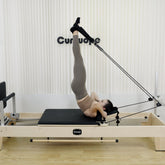What are the 7 principles of Pilates?Any good suggestions?
The Pilates method is based on a set of principles that guide the practice of the exercises. These principles were developed by Joseph Pilates, the founder of the method, and are designed to help students understand and apply the concepts of Pilates to their daily lives. There are seven core principles of Pilates, which are outlined below.

Concentration
Concentration is one of the foundational principles of Pilates. In order to perform the exercises correctly and effectively, you need to be fully present and focused on the task at hand. By concentrating on your breath, alignment, and movement, you can engage the mind-body connection and achieve greater awareness of your body.
Control
Control refers to the precise, intentional movements that are central to Pilates. Rather than relying on momentum or brute force, Pilates practitioners are encouraged to use their muscles in a controlled, deliberate way. This helps to build strength and flexibility while also reducing the risk of injury.
Centering
Centering refers to the idea that all movement should originate from the center of the body, specifically the muscles of the core. By engaging the muscles of the abdomen, back, hips, and pelvis, you can create a strong, stable foundation for movement and prevent injury.
Breath
Breathing is a fundamental component of Pilates, and it is often described as the link between the mind and body. By focusing on the breath, you can calm the mind, reduce stress, and increase oxygen flow to the muscles. Proper breathing can also help to facilitate movement and increase your overall endurance.
Flow
Flow refers to the smooth, continuous movement that characterizes Pilates exercises. Rather than performing isolated movements, Pilates practitioners aim to create a seamless, flowing sequence of movements that engage the entire body. This helps to build strength and flexibility while also improving overall coordination and movement efficiency.
Precision
Precision is another key principle of Pilates, and it refers to the attention to detail that is required to perform the exercises correctly. Each movement should be performed with precision and accuracy, with a focus on proper alignment and technique. This helps to maximize the benefits of the exercises while minimizing the risk of injury.
Alignment
Alignment is the final principle of Pilates, and it refers to the proper positioning of the body during exercise. By maintaining good alignment, you can improve posture, prevent injury, and maximize the effectiveness of the exercises. Pilates practitioners focus on aligning the spine, pelvis, and other joints to create a stable, balanced foundation for movement.
If you're interested in learning more about the principles of Pilates, there are a few things you can do. First, consider finding a qualified Pilates instructor who can guide you through the proper techniques and form. Look for someone who is certified by a reputable organization, such as the Pilates Method Alliance. Second, consider investing in a good quality Pilates mat or equipment, such as a reformer or a stability ball. Finally, be patient and persistent in your practice. Like any form of exercise, Pilates requires time, effort, and dedication to see results. But with consistent practice, you can enjoy the many physical and mental benefits of this effective and enjoyable exercise method.





